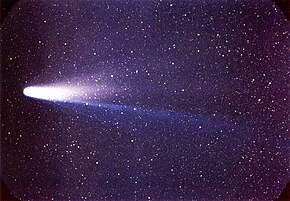
Back Halley se Komeet Afrikaans مذنب هالي Arabic Cometa Halley AST Halley kometası Azerbaijani Галлей кометаһы Bashkir Камета Галея Byelorussian Камэта Галея BE-X-OLD Халеева комета Bulgarian হ্যালির ধূমকেতু Bengali/Bangla Halleyjeva kometa BS
 Halley's Comet on 8 March 1986 | |
| Discovery | |
|---|---|
| Discovered by | Prehistoric (observation) Edmond Halley (recognition of periodicity) |
| Discovery date | 1758 (first predicted perihelion) |
| Orbital characteristics[1] | |
| Epoch 4 August 2061 (2474040.5) | |
| Aphelion | 35.14 au[2] (aphelion: 9 December 2023)[2][3] |
| Perihelion | 0.59278 au[4] (last perihelion: 9 February 1986) (next perihelion: 28 July 2061)[4] |
| 17.737 au | |
| Eccentricity | 0.96658 |
| 74.7 yr 75y 5m 19d (perihelion to perihelion) | |
| 0.07323° | |
| Inclination | 161.96° |
| 59.396° | |
| 28 July 2061[4][5] ≈27 March 2134[6][5] | |
| 112.05° | |
| Earth MOID | 0.075 au (11.2 million km) (epoch 1968)[7] |
| TJupiter | -0.598 |
| Physical characteristics | |
| Dimensions | 15 km × 8 km[8] |
Mean diameter | 11 km[7] |
| Mass | 2.2×1014 kg[9] |
Mean density | 0.6 g/cm3 (average)[10] 0.2–1.5 g/cm3 (est.)[11] |
| ~0.002 km/s | |
| 2.2 d (52.8 h) (?)[12] | |
| Albedo | 0.04[13] |
| 28.2 (in 2003)[14] | |
Halley's Comet, Comet Halley, or sometimes simply Halley, officially designated 1P/Halley, is the only known short-period comet that is consistently visible to the naked eye from Earth,[15] appearing every 75–79 years.[1] It last appeared in the inner parts of the Solar System in 1986 and will next appear in mid-2061.
Halley's periodic returns to the inner Solar System have been observed and recorded by astronomers around the world since at least 240 BC, but it was not until 1705 that the English astronomer Edmond Halley understood that these appearances were re-appearances of the same comet. As a result of this discovery, the comet is named after Halley.[16]
During its 1986 visit to the inner Solar System, Halley's Comet became the first comet to be observed in detail by spacecraft, providing the first observational data on the structure of a comet nucleus and the mechanism of coma and tail formation.[17][18] These observations supported a number of longstanding hypotheses about comet construction, particularly Fred Whipple's "dirty snowball" model, which correctly predicted that Halley would be composed of a mixture of volatile ices—such as water, carbon dioxide, and ammonia—and dust. The missions also provided data that substantially reformed and reconfigured these ideas; for instance, it is now understood that the surface of Halley is largely composed of dusty, non-volatile materials, and that only a small portion of it is icy.
- ^ a b Cite error: The named reference
MPCwas invoked but never defined (see the help page). - ^ a b Cite error: The named reference
Horizons2023was invoked but never defined (see the help page). - ^ Cite error: The named reference
seeker2013was invoked but never defined (see the help page). - ^ a b c Cite error: The named reference
Horizons2061was invoked but never defined (see the help page). - ^ a b Cite error: The named reference
Kinoshitawas invoked but never defined (see the help page). - ^ Cite error: The named reference
Horizons2134was invoked but never defined (see the help page). - ^ a b Cite error: The named reference
jpldatawas invoked but never defined (see the help page). - ^ Cite error: The named reference
Learnwas invoked but never defined (see the help page). - ^ Cite error: The named reference
masswas invoked but never defined (see the help page). - ^ Cite error: The named reference
densitywas invoked but never defined (see the help page). - ^ Cite error: The named reference
Peale1989Novemberwas invoked but never defined (see the help page). - ^ Cite error: The named reference
Peale1989was invoked but never defined (see the help page). - ^ Cite error: The named reference
darkwas invoked but never defined (see the help page). - ^ Cite error: The named reference
ESO2003was invoked but never defined (see the help page). - ^ Cite error: The named reference
Delehantywas invoked but never defined (see the help page). - ^ Halley, Edmund (1705). A synopsis of the astronomy of comets. Oxford: John Senex. Retrieved 16 June 2020 – via Internet Archive.
- ^ Cite error: The named reference
postwas invoked but never defined (see the help page). - ^ Cite error: The named reference
situwas invoked but never defined (see the help page).
© MMXXIII Rich X Search. We shall prevail. All rights reserved. Rich X Search